Beginners Guide to House Plants
Indoor plants have risen in popularity and become a vital element of interior design. House plants can revitalise an indoor area and are known to have air-purifying and mood-enhancing abilities. The world of indoor door plants can seem overwhelming if you're not sure where to look, that's why we've cut out the nonsense and created this article, showing you precisely what you need to know.
We've included the best house plants for not only beginners, but for intimidates and experts too. If your houseplants are suffering from an unknown disease, don't panic, we've covered how to spot common diseases and how to treat your house plants back to full health.
Unwelcome insects love to munch on unsuspecting houseplants, and the little critters can be difficult to identify and get rid of. We've dedicated an entire section on identifying what insect is chomping on your houseplants and how to get rid of them once and for all.
Worried about how to care for your new houseplant? We've dedicated a section on houseplant care requirements, including light, soil, space and water needs, so you don't have to guess and you know exactly what's essential to your houseplant.
If you're interested in starting your house plant collection (trust us, it becomes addictive!), continue reading our handy guide to get you started, or to help along your knowledge!
Best House Plants for Beginners
If you are new to growing house plants, there are certain plants which are easier to grow and maintain. For this section, we will look at some examples you might consider such as Peace Lilies, Cacti and Succulents.
Snake Plant
A snake plant is an example of a popular house plant, and it is also especially robust, which makes it a great plant to start with for newcomers. It's simple to grow, and it takes a lot to kill this plant. This means you have room for errors in the process and can learn as you go.
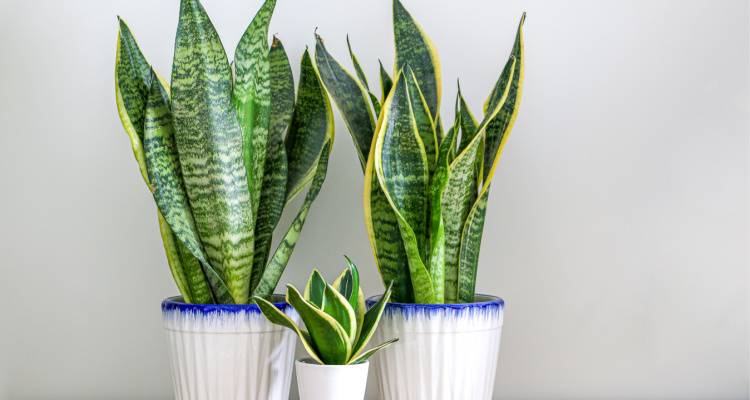
| Light Requirements | Indirect sunlight, low-light conditions. |
| Soil Requirements | Soil-less potting mix/Fast-draining, sandy soil. |
| Watering Frequency | Every 2-8 weeks (when the soil is about to become completely dry). |
| Temperature Requirements | 15°C to 27°C at day & 12.5°C to 21°C at night. |
| Space Requirements | A tabletop or floor will provide suitable space for this plant initially. If it grows too high, then the floor may be the only appropriate space. |
| Average Height | 0.6 to 1.2 metres. |
| Maximum Height | About 3.6 metres. |
| How Often Does It Need Re-potting? | Every year or two in late winter. |
| Do These Plants Flower? | Rarely. Mild levels of stress may result in white/cream coloured blossoming with flowers that are similar in appearance to lilies. |
| When Do They Go Dormant? | Snake plants will likely go dormant during the winter. |
Spider Plant
Spider plants, named so because of how the plantlets and offshoots at the end of its stems look somewhat spider-like, are other common and easy house plants to manage. Spider Plants are examples of air purifying house plants. Aside from brown tips, this plant rarely has problems and is highly adaptable to different environments.
| Light Requirements | Filtered sunlight or partial shade. |
| Soil Requirements | Free drainage soil. |
| Watering Frequency | Once a week (or when about an inch of the soil has become dry). |
| Temperature Requirements | 21°C to 32°C degrees. |
| Space Requirements | No specific requirements as they tend not to grow to a particularly tall height. |
| Average Height | 0.1 to 0.3 metre. |
| Maximum Height | 0.3 metre. |
| How Often Does It Need Re-potting? | Every 2 years. |
| Do These Plants Flower? | Rarely. |
| When Do They Go Dormant? | Spider Plants will likely go dormant during the winter months. |
Peace Lily
A Peace Lily is a tropical, evergreen plant. It is another example of a house plant which is easy to maintain.
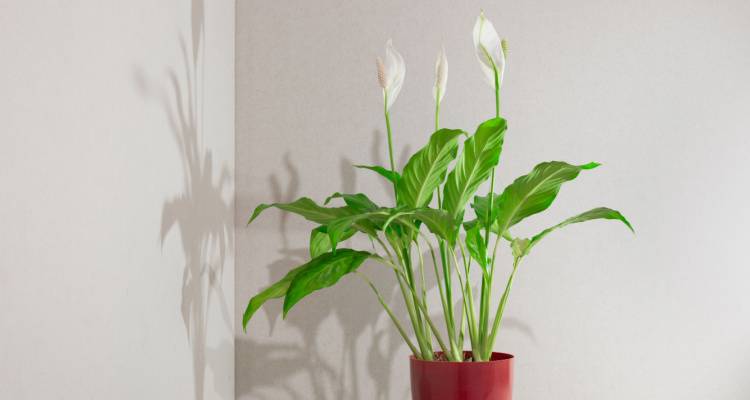
| Light Requirements | Medium levels of light/indirect sunlight |
| Soil Requirements | Potting mix that is peat-based. |
| Watering Frequency | About once a week. |
| Temperature Requirements | 20 to 30°C. |
| Space Requirements | No specific requirements. |
| Average Height | 0.45 to 0.6 metre. |
| Maximum Height | Depends on the species. |
| How Often Does It Need Re-potting? | Once a year, in the spring. |
| Do These Plants Flower? | Yes. They tend to flower in the spring and early summer. |
| When Do They Go Dormant? | No, unlike many house plants, they continue to grow throughout the year. |
Golden Pothos Vine
Considered by many to be one of the simplest house plants to grow, Golden Pothos Vine as with a Peace Lily should only be watered when the soil goes dry. This plant is quite sturdy and probably won't be doomed if it’s accidentally under-watered a few times.
| Light Requirements | Bright but filtered light or low-light. If kept in low-light, consider giving it 1 to 2 hours of moderate sun intake. |
| Soil Requirements | Soil-based potting mix. |
| Watering Frequency | Every 3-7 days (when its soil goes dry, and the plant starts to droop). |
| Temperature Requirements | 15°C to 30°C. |
| Space Requirements | You might find it is most appropriate to be placed on the floor in a suitable location if it grows too tall. It could quickly outgrow its suitability of being a tabletop plant. |
| Average Height | 2 to 3 metres. |
| Maximum Height | 6 metres+ |
| How Often Does It Need Re-potting? | Perhaps once every 2 years although it depends. You'll want to re-pot once the roots are blocking the drainage holes or if the plant is pulling out from the soil itself. |
| Do These Plants Flower? | Not often. If it reaches 10 metres or more in height, then you may begin to see flowers bloom although this is rare. |
| When Do They Go Dormant? | These plants may go slightly dormant during the winter. |
Dracaena
Dracaena is another easy to grow plant of African origin. This particularly beautiful plant is a part of the asparagus family.
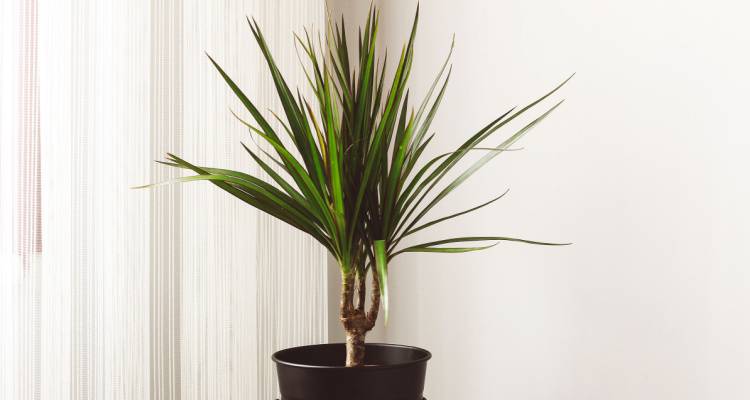
| Light Requirements | Filtered sunlight captured indoors. Not tolerable to low-light. |
| Soil Requirements | Well-draining potting soil that is rich in nutrients and organic matter. |
| Watering Frequency | Water only after the top of the soil has gone dry. |
| Temperature Requirements | 18°C to 32°C. |
| Space Requirements | No specific requirements unless it becomes too tall then find an appropriate spot on the floor. |
| Average Height | Depends greatly on the specific type of Dracaena plant. May range from 0.3 to 6 metres. |
| Maximum Height | Depends on the species. |
| How Often Does It Need Re-potting? | Roughly every 2 to 3 years. |
| Do These Plants Flower? | May flower once a year under the right conditions. In some cases, they can even bloom more than once each year. |
| When Do They Go Dormant? | Dracaena plants do not go into complete dormancy, but they will display a limited level of dormant behaviour during the winter. |
Bromeliads
Bromeliads are colourful and exotic plants that offer great aesthetic value. Simple to grow, these plants require mid to bright light when grown indoors.
| Light Requirements | Tolerable to a wide-range of lighting conditions. |
| Soil Requirements | Soil which drains well. |
| Watering Frequency | About once each week. You might need to mist Bromeliads regularly if humidity levels are less than 60%. |
| Temperature Requirements | 21°C to 32°C. |
| Space Requirements | Usually, no specific requirements. If it grows too tall, then find a good location on the floor for your plant to continue growing. |
| Average Height | 0.6 to 0.9 metres |
| Maximum Height | 3 metres. |
| How Often Does It Need Re-potting? | Often it won't require re-potting. However, if the roots start reaching out of the drainage holes, then you should re-pot. |
| Do These Plants Flower? | Bromeliads will often flower within a year and a half. With few exceptions, these plants only bloom once in their lifetime. |
| When Do They Go Dormant? | In most cases, Bromeliads will go dormant during the winter. |
Succulents
Succulents are among the most popular house plants, and they are also low-maintenance. Many succulents are also cheap house plants. These plants are naturally tolerant to drought, so the risk of under-watering being fatal is quite low.
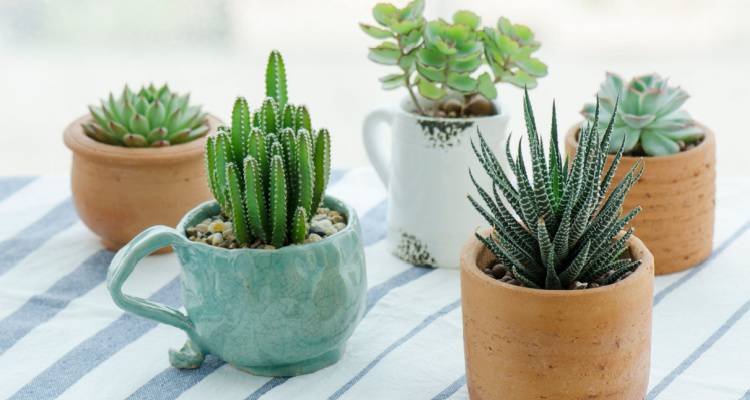
| Light Requirements | You can use LED lights if kept about 0.4 to 0.6 metre from the succulents. Succulents, unlike many plants, do not necessarily need sunlight. |
| Soil Requirements | Sandier potting soil. |
| Watering Frequency | A minimum of once per week. |
| Temperature Requirements | 15°C to 27°C. |
| Space Requirements | Generally, no specific requirements, although if it becomes too large then find a suitable space on the floor. |
| Average Height | Varies greatly depending on species. Ranges from 0.02 to 3.7 metres. |
| Maximum Height | Depends on the species. |
| How Often Does It Need Re-potting? | About every two years. |
| Do These Plants Flower? | Yes, they can although it depends on the plant and when they'll flower will also vary. |
| When Do They Go Dormant? | During the winter months. |
Lucky Bamboo
Lucky Bamboo, despite its name, is actually a type of Dracaena plant. Its name comes from the fact that its stems resemble bamboo shoots. Once more, this plant is easy to look after and is tolerant of under-watering.
| Light Requirements | Bright but indirect light. |
| Soil Requirements | Rich potting soil that is well-drained. Soil must remain moist. |
| Watering Frequency | Twice a week for a new plant and enough to achieve satisfactory drainage and good aeration afterwards. |
| Temperature Requirements | 18°C to 35°C. |
| Space Requirements | No specific requirements as this plant tends not to grow too high. |
| Average Height | About 1 metre. |
| Maximum Height | Tends to be about 1.5 metres. |
| How Often Does It Need Re-potting? | Roughly every 3 to 5 years (once the roots have filled the pot, and there is no more room). |
| Do These Plants Flower? | No, not as an indoor plant. They can in nature, however. |
| When Do They Go Dormant? | Lucky Bamboo tends to go dormant during the winter months. |
Cacti
Growing a cactus is a simple and enjoyable alternative to growing more conventional plants. Cacti are among the most common house plants. These plants evolved to be especially hardy, surviving in the toughest conditions of parched deserts and as a result, they require little water or maintenance.
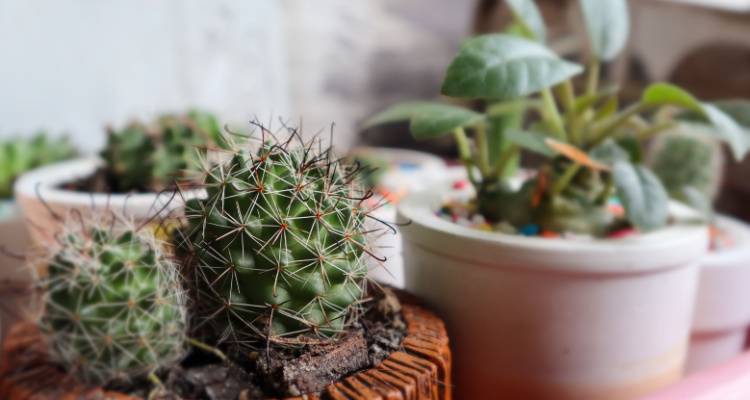
| Light Requirements | 10-14 hours of light per day. Most Cacti need to be in sunlight or in indirect but bright light. It does vary depending on the species, however. |
| Soil Requirements | Ordinary potting soil or African violet soil. Many stores provide cactus-specific soil. |
| Watering Frequency | About once every week. |
| Temperature Requirements | 18°C to 32°C most of the time but only 7°C to 10°C during the winter months for ideal conditions. |
| Space Requirements | No specific requirements unless it grows too tall. Generally, a cactus can fit on a tabletop, mantle-piece or by the window. |
| Average Height | Most household cacti grow to 10 cm after a few years while some can grow to perhaps half a metre in the same length of time. |
| Maximum Height | Depends on the species. |
| How Often Does It Need Re-potting? | Roughly every 2 to 4 years (re-pot once the roots of the plant begin to appear through the bottom of the drainage holes). |
| Do These Plants Flower? | Cacti may bloom as they mature and when exactly they will flower depends on the particular type of Cacti in question. |
| When Do They Go Dormant? | Cacti will tend to go dormant through the autumn and winter months. |
Heartleaf Philodendron
A Heartleaf Philodendron is an easy to manage plant which works well as a table-top plant or as a hanging plant.
| Light Requirements | Bright but indirect and filtered light. |
| Soil Requirements | Can be grown in peat moss soil or just in water. |
| Watering Frequency | Roughly every 2 days during the hotter months and once or twice a week during the colder months. |
| Temperature Requirements | 18°C to 24°C is ideal. |
| Space Requirements | A tabletop or hanging spot should suffice. However, if it grows too tall, then a spot on the floor may be preferable. |
| Average Height | Several metres. |
| Maximum Height | 6 metres+ |
| How Often Does It Need Re-potting? | If you are using soil, then you should re-pot after about 6 months as these plants can grow quite tall. |
| Do These Plants Flower? | Not very often. |
| When Do They Go Dormant? | During the winter months. |
Cast Iron Plant
Cast Iron Plants are native to Taiwan and Japan and are relatively easy to grow.
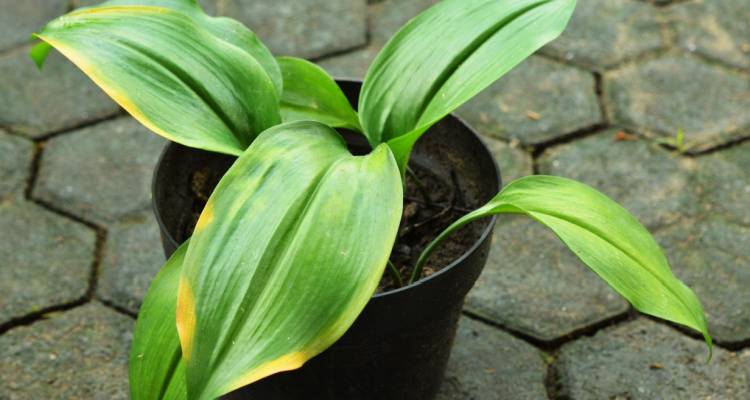
| Light Requirements | Low or bright filtered light. |
| Soil Requirements | Potting soil with a pH level between 5.5 and 6.5. |
| Watering Frequency | Allow the top half of the soil to dry before watering. |
| Temperature Requirements | 15°C to 24°C is fine although the temperature of the room it is in should not drop below 8°C. |
| Space Requirements | No specific requirements. |
| Average Height | About 0.6 metres. |
| Maximum Height | Up to 1 metre or more. |
| How Often Does It Need Re-potting? | Usually, only once every 3-4 years. |
| Do These Plants Flower? | Rarely and is usually not noticeable. |
| When Do They Go Dormant? | In the winter months. |
Best House Plants for Intermediates
If you have some experience with house plants although you do not yet classify yourself as an expert, then there are many plants out there that are ideal for you to try next. Included on this list are the Jade Plant, African Violet and Basil Plant.
Money Plant
Pachira Aquatica is one of two plants labelled as a ‘Money Plant'. Unfortunately, this plant does not grow currency; however, it is reputed for bringing good luck. This plant, as with each of the plants discussed in this section, require a little more care and attention than the plants mentioned in the section for beginners.
| Light Requirements | Mid to bright but indirect light. |
| Soil Requirements | Well-drained, peat-moss soil that is also sandy is preferable. |
| Watering Frequency | Once or twice a week. Rotate the plant after each watering. |
| Temperature Requirements | 15°C to 30°C. |
| Space Requirements | May not be suitable for a counter top or a space with little room to grow upwards. An appropriate spot on the floor is probably ideal as the plant is likely to surpass a height of 1 metre. |
| Average Height | 1-2 metres. |
| Maximum Height | Up to about 2 to 2.5 metres. |
| How Often Does It Need Re-potting? | Roughly every 2 years (once the roots start pushing out through the drainage holes). |
| Do These Plants Flower? | A money tree might flower every spring, although the ideal lighting conditions will likely be required to achieve this. |
| When Do They Go Dormant? | This plant will usually go dormant during the winter months. |
Air Plant
Air Plants (Tillandsia) are named as such since they obtain most of their nutrients through the air and are considered examples of hanging house plants. They are also unusual house plants since they do not require soil. They are evergreen perennial plants which can flower and are another good choice for intermediates because of the somewhat increased complexities in their maintenance regiment.
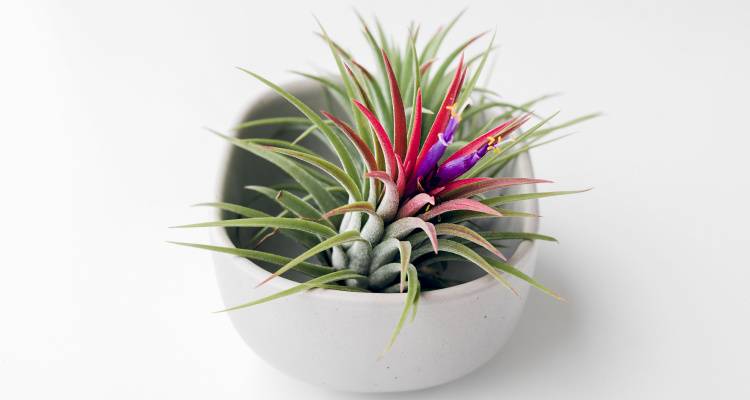
| Light Requirements | Bright but indirect light. South or east-facing rooms are ideal. |
| Soil Requirements | No soil required. Unlike the vast majority of houseplants, Air Plants do not need soil as a medium to grow in. |
| Watering Frequency | At least once a week although 2-3 times a week is preferable. Without soil or a pot, you need to soak these plants in a bowl of water for about 20 minutes on average. |
| Temperature Requirements | 10°C to 32°C. |
| Space Requirements | No specific requirements. |
| Average Height | 0.1 to 0.2 metres. |
| Maximum Height | 0.25 metres or taller. |
| How Often Does It Need Re-potting? | You don't need a pot for these plants. Just make sure you put them in a location or container where they have enough room to grow. |
| Do These Plants Flower? | Air Plants will usually bloom once in their lifetime and often as with most house plants will happen sometime in and around the spring. Further, this flowering should last for about 2-3 weeks. |
| When Do They Go Dormant? | Air Plants will go dormant during the winter months. |
Jade Plant
Jade Plants are a form of succulent plants and are also known as a ‘Money Plant' like the Pachira Aquatica Plant. They tend to have a good lifespan and are quite stalwart. Managing this plant is relatively easy, although there are more specifics to consider than with most of the plants listed for beginners.
| Light Requirements | At least 4 hours of sunlight per day. New, young plants should be sustained in indirect but bright sunlight. The larger the plant, the more sunlight it will manage. |
| Soil Requirements | An all-purpose potting mix will work just fine although some recommend a mix of 60% sand, 20% peat moss and 20% organic material. |
| Watering Frequency | Roughly two or three times a month. You should let the top 1 to 2 inches of the soil go dry first and then water. |
| Temperature Requirements | 18°C to 24°C during the daytime and 10°C to 13°C at night. |
| Space Requirements | Should not require any specific spacing conditions unless it grows too tall. |
| Average Height | 0.3 metres. |
| Maximum Height | Up to about 4 metres for some species although this is rare. |
| How Often Does It Need Re-potting? | You should re-pot roughly every 2 to 3 years. As the plant gets older, re-potting may only be necessary every 4 to 5 years. |
| Do These Plants Flower? | Yes. Jade Plants often flower annually from late winter to early spring. |
| When Do They Go Dormant? | They will enter dormancy during the winter. |
African Violet
African Violets are gorgeous plants which tend to flower beautifully with a lavender spectrum of colours. As with the other plants in this section, while this plant is not especially difficult to maintain once you pay close attention to its needs and act accordingly, it is more at risk of dying if neglected. For example, this plant is more vulnerable to dying if not kept at the right temperature in comparison to most of the plants mentioned in the beginners' section.
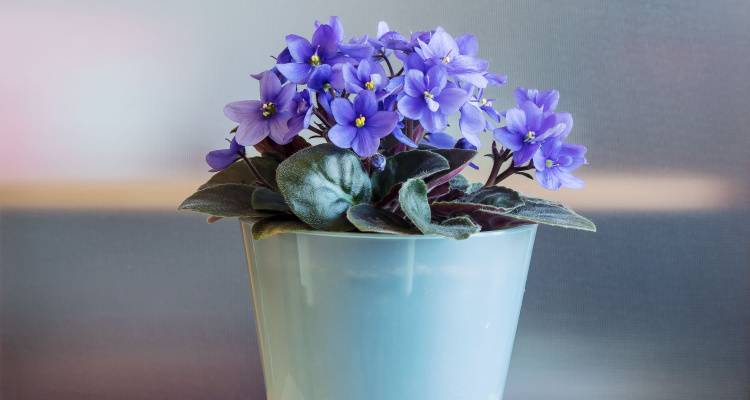
| Light Requirements | Medium to bright but indirect light. |
| Soil Requirements | Potting soil which is primarily based around peat-moss. |
| Watering Frequency | Perhaps once a month (once the top of the soil has gone dry). |
| Temperature Requirements | 18°C to 24°C is about right while 10°C or below can be fatal. |
| Space Requirements | No specific requirements. |
| Average Height | 0.1 to 0.3 metres. |
| Maximum Height | 0.3 metres or more. |
| How Often Does It Need Re-potting? | Re-pot roughly twice a year. |
| Do These Plants Flower? | African Violets can bloom throughout the year and achieve this for years on end. However, in order to achieve this, you need to take care of the plant's requirements meticulously. If you do, you will be rewarded with gorgeous and continuous flowering. |
| When Do They Go Dormant? | African Violets will not enter a dormant period once they are well maintained. |
English Ivy
English Ivy or Common Ivy are evergreen perennial plants that are often straightforward to maintain. However, there is a range of caveats to consider, such as the relatively narrow temperature range to maintain the plant's health status, which makes it a good plant to look after for intermediates.
| Light Requirements | Filtered bright light or in low-light conditions. |
| Soil Requirements | Well-drained soil that is rich and plentiful in organic matter. |
| Watering Frequency | Once per week should suffice. |
| Temperature Requirements | 15°C to 18°C during daylight and about 10°C at night. |
| Space Requirements | Should not include any specific spacing requirements. If it becomes too tall, then placing it in a suitable area on the room of the floor would be the best option. |
| Average Height | About 0.2 metres. |
| Maximum Height | Perhaps up to as much as 1 to 2.5 metres. |
| How Often Does It Need Re-potting? | Roughly every 2 to 3 years. |
| Do These Plants Flower? | Yes, they can flower, and they will often flower in the spring, although how often and how likely this is to happen depends on the species and the individual plant. |
| When Do They Go Dormant? | Generally, English Ivy will become somewhat dormant during the winter season. |
Dumb Cane Plant
Dumb Cane Plants are sturdy plants. However, as a warning, these plants are highly toxic for cats and dogs and many other animals for that matter. It is important to always take the necessary precautions if you wish to purchase a plant that has risks associated with it. This fact and the increased complexities in maintaining these plants makes it a good choice for intermediates in plant management.
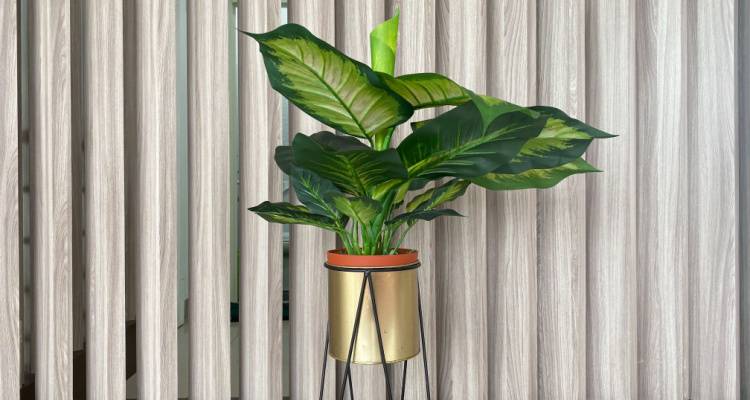
| Light Requirements | Low and filtered light should work fine. |
| Soil Requirements | Well-drained and moist potting soil. More complex choices include; 60% sphagnum peat, 20% perlite and 20% vermiculite. Topsoil and peat in a 50:50 ratio or peat and perlite in the same ratio are two other choices that could work. |
| Watering Frequency | Once per week (once the soil is dry on at least the top inch). |
| Temperature Requirements | 15°C to 24°C. |
| Space Requirements | May not include any specific requirements unless it grows too tall for a given spot such as a tabletop. |
| Average Height | 0.7 to 1 metre. |
| Maximum Height | 1.2 to 1.6 metres. |
| How Often Does It Need Re-potting? | Re-pot if you find the plant becomes too large for the pot and then after that roughly every 2 to 3 years. |
| Do These Plants Flower? | Rarely. Most of these plants will never bloom, and they will only bloom in ideal conditions. However, this will give you a good challenge if it interests you. |
| When Do They Go Dormant? | Dumb Cane Plants become dormant during the winter. |
Basil Plant
Basil Plants are tender plants and are a good choice for intermediates because of their unique requirements, including their lighting and soil requirements.
| Light Requirements | A warm, sunny spot and 6-8 hours of sunlight per day. If you live in a particularly warm climate, then you should give basil some shade during the afternoon hours. |
| Soil Requirements | Well-drained soil that is moist and with a neutral pH level. |
| Watering Frequency | Once a week. |
| Temperature Requirements | 24°C to 28°C. |
| Space Requirements | No specific requirements. |
| Average Height | 0.3 to 0.6 metres. |
| Maximum Height | 0.4 to 0.6 metres. |
| How Often Does It Need Re-potting? | It really depends but once the stems begin to appear out of the bottom of the drainage holes then you should re-pot the plant. |
| Do These Plants Flower? | Basil plants can bloom, but the frequency of these plants flowering varies significantly. |
| When Do They Go Dormant? | Basil plants will likely go dormant in the winter. They often tend not to survive very long, however. |
Rubber Plant
Rubber Plants or Rubber Figs are native to Asia. They are a good candidate for intermediates as they are a bit trickier to manage than the plants we've recommended for beginners.
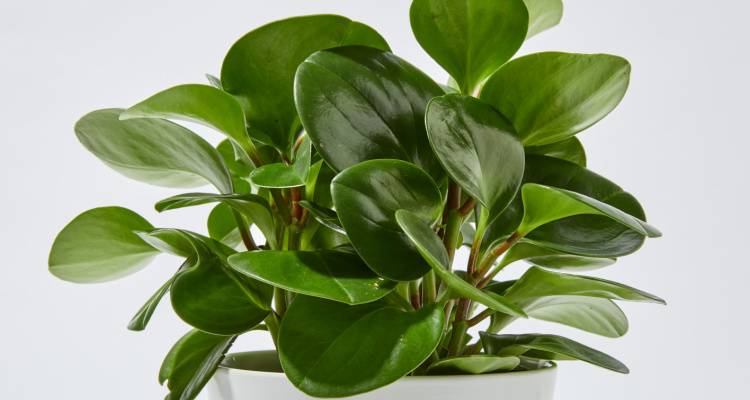
| Light Requirements | Bright but indirect sunlight. |
| Soil Requirements | Well-draining soil. A mix such as that of coarse sand, peat and pine bark of equal amounts would work well. |
| Watering Frequency | Once the soil goes dry, then water. |
| Temperature Requirements | 23°C to 27°C at daytime and 15°C to 18°C at night. |
| Space Requirements | Usually, no specific requirements. If it grows too tall, then find a good location on the floor for your plant to continue growing. |
| Average Height | 2-3 metres. |
| Maximum Height | 3 metres+ |
| How Often Does It Need Re-potting? | Roughly once every 3 years. |
| Do These Plants Flower? | Yes, and usually outside of the dormant months. |
| When Do They Go Dormant? | During the winter months. |
Pilea Plant
Pilea Plants or Chinese Money Plants are a good challenge for intermediates as among other specifics; they require the use of a particular ‘drench and dry' approach to watering.
| Light Requirements | Bright but indirect light. Do not expose it to full direct sunlight. |
| Soil Requirements | Well-drained potting mix. |
| Watering Frequency | Before the soil dries out, they should be re-watered, particularly in the summer. Use a ‘drench and dry' approach. Water heavily before allowing it to go very dry. Then repeat the process. |
| Temperature Requirements | Above 10°C. |
| Space Requirements | No specific requirements. |
| Average Height | 0.3 metres. |
| Maximum Height | Half a metre or more. |
| How Often Does It Need Re-potting? | Roughly once every 2 years. |
| Do These Plants Flower? | Not often. |
| When Do They Go Dormant? | During the winter months to early spring. |
Best House Plants for The Experts
If you consider yourself an expert in house plant management, then this section is for you. Among these generally indoor house plants are Boston Fern Plants, Mini Roses, Gardenias and Fiddle-Leaf Fig Trees.
Azalea Plant
An Azalea Plant is a shrub plant which blooms beautifully in the spring if well taken care of. This plant is a good choice for experts as its requirements are more specific than many of the plants that we discussed for beginners or intermediates.
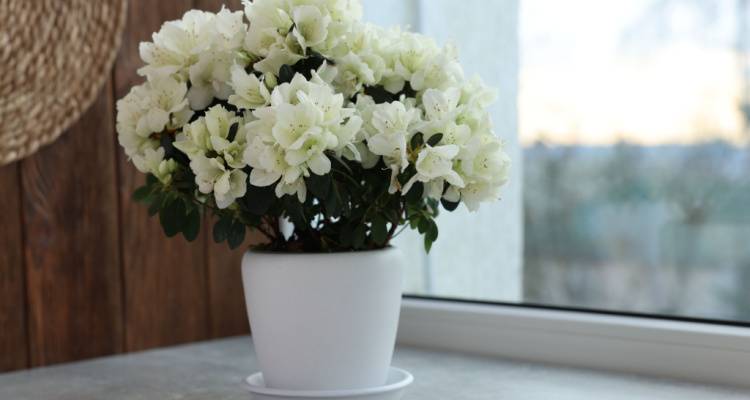
| Light Requirements | Part shade or in full sun. |
| Soil Requirements | Well-drained moist soil with plenty of organic material. Should a pH level of about 5.5. Ideal organic matter for this soil could include compost, ground bark and peat. |
| Watering Frequency | Once every 10 to 14 days. An Azalea Plant has to be kept consistently moist throughout, albeit this plant will not survive in soggy soil. Finding the right balance is essential. |
| Temperature Requirements | Up to 20°C during daylight hours and between 7°C and 10°C at night. |
| Space Requirements | A suitable location on the floor should be chosen if you expect your plant to grow to several metres in height. |
| Average Height | Massive range depending on the species from as little as 0.1 metres to as much as 7 metres. |
| Maximum Height | 7 metres or more. |
| How Often Does It Need Re-potting? | About once every 2 years. |
| Do These Plants Flower? | Yes. Most Azalea Plants will bloom from late winter to early spring, but on some occasions, they can bloom at different times throughout the whole year. |
| When Do They Go Dormant? | Late Autumn and through the winter. |
Boston Fern Plant
A Boston Fern or Sword Fern is an evergreen perennial and herbaceous plant. It is more difficult to manage than a plant for beginners or intermediates as its needs are quite specific.
| Light Requirements | Bright but indirect sunlight. |
| Soil Requirements | Potting soil that is peat-based with materials such as perlite or vermiculite. |
| Watering Frequency | Do not allow the soil to dry out. As the soil becomes just a little damp, you'll need to water this plant. That could mean watering it say twice per week although during the hot summer months this may need to be done every day. |
| Temperature Requirements | 20°C to 26°C. |
| Space Requirements | No specific requirements. |
| Average Height | 0.3 to 1 metre. |
| Maximum Height | About 1 metre. |
| How Often Does It Need Re-potting? | Roughly every 2 years. |
| Do These Plants Flower? | No. Ferns are not flowering plants. |
| When Do They Go Dormant? | Boston Ferns do not technically become dormant during the winter although they might display dormant-like behaviour. |
Miniature Roses
Miniature Roses or just Mini Roses are beautiful and sturdy plants. However, meeting their exact requirements is essential in order for these plants to live long prosperous lives.
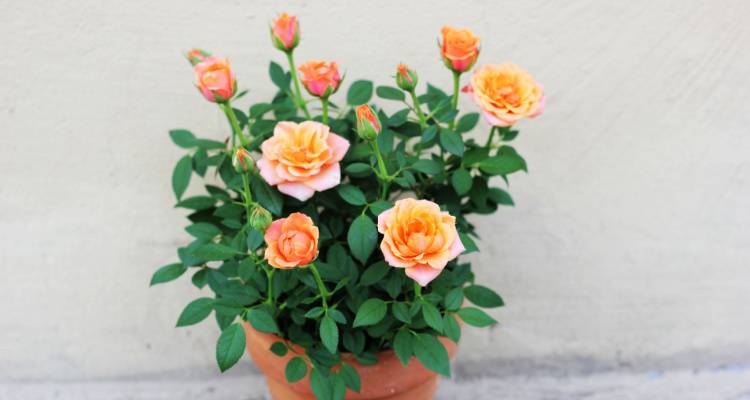
| Light Requirements | Direct sunlight. |
| Soil Requirements | Well-drained and loamy soil. |
| Watering Frequency | About once per week during the winter but daily in the summer months. Find the right balance in between for the spring and autumn months. |
| Temperature Requirements | About 21°C during the day but at least 15.5°C at night. |
| Space Requirements | No specific requirements. |
| Average Height | 0.4 metres. |
| Maximum Height | About 0.7 metres. |
| How Often Does It Need Re-potting? | Re-pot in the autumn on a year when the roots are appearing out of the bottom of the drainage holes. |
| Do These Plants Flower? | These plants can bloom throughout the year, although more so during spring and summer. |
| When Do They Go Dormant? | Autumn through the winter. |
Orchid
Orchids are a family of flowering plants. These are another good test for experts because of the increased challenge they offer to plant owners.
| Light Requirements | Bright but indirect sunlight is preferred. |
| Soil Requirements | A mixture of bark and peat moss with a 2:1 ratio is ideal. You can buy Orchid bark mixes in many stores. |
| Watering Frequency | Once per week during the colder months and twice a week in the summer. |
| Temperature Requirements | 18°C to 27°C during the day and 15°C to 21°C at night. |
| Space Requirements | Usually, no specific requirements. If it grows too tall, then find a good location on the floor for your plant to continue growing. |
| Average Height | 0.3 to 1 metre. |
| Maximum Height | Above 1 metre. |
| How Often Does It Need Re-potting? | Roughly every year or two. |
| Do These Plants Flower? | Yes, and they will often bloom from late autumn through to the early to mid-spring. |
| When Do They Go Dormant? | Dormancy can appear at different times of the year and may last for 6 to 9 months. It won't necessarily occur in any given year. |
Zebra Plant
Zebra Plants are tropical plants native to Brazil which tend to flower around the end of summer. They have quite specific needs such as their temperature requirements making them a good undertaking for an expert plant owner.
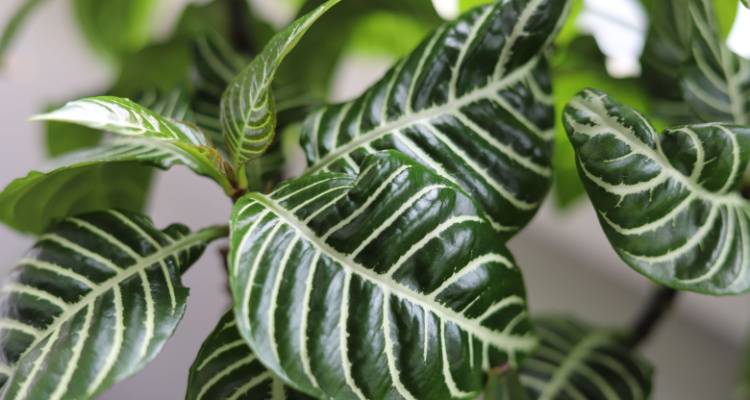
| Light Requirements | Bright but indirect sunlight. |
| Soil Requirements | Potting soil that is rich and organic-based. |
| Watering Frequency | Water with a light fertiliser during the winter once every fortnight. Ultimately you want to water just before the soil dries out. You may need to water frequently during the summer. |
| Temperature Requirements | Many Zebra Plants require temperatures above 16°C, but some larger plants will need temperatures of 21°C or more. |
| Space Requirements | Usually, no specific requirements. Move to the floor if it grows too tall for another location. |
| Average Height | 0.3 to 0.6 metres. |
| Maximum Height | About 2 metres. |
| How Often Does It Need Re-potting? | Every few years (or when the roots begin to appear out of the drainage holes). |
| Do These Plants Flower? | Yes, they tend to bloom between late summer and autumn. |
| When Do They Go Dormant? | During the winter season, Zebra Plants will probably enter a semi-dormant state. |
Banana Plant
Not to be confused with a banana tree, a household banana plant is still capable of producing bananas if grown in the ideal conditions. Banana plants are large house plants relative to most. This is a good task for experts as it includes specifics such as growing the plant in soil with just the right pH level.
| Light Requirements | Many hours of direct, bright sunlight every day. |
| Soil Requirements | Well-drained and organic-based with a pH level between 5.5 and 7.0. |
| Watering Frequency | Water after the plant has dried out for a brief period of time. |
| Temperature Requirements | About 26°C during the day and roughly 19°C at night. |
| Space Requirements | A suitable spot on the floor with plenty of headroom to grow. |
| Average Height | 2-4 metres. |
| Maximum Height | 5 metres+ |
| How Often Does It Need Re-potting? | Usually every 2 to 3 years. Re-potting should be done in the springtime. |
| Do These Plants Flower? | Spring to early summer. |
| When Do They Go Dormant? | During the winter months. |
Gardenia
Gardenia refers to a genus of flowering plants native to Africa, Asia and the Pacific. They have special requirements when it comes to soil and watering making it a good match for expert plant owners.
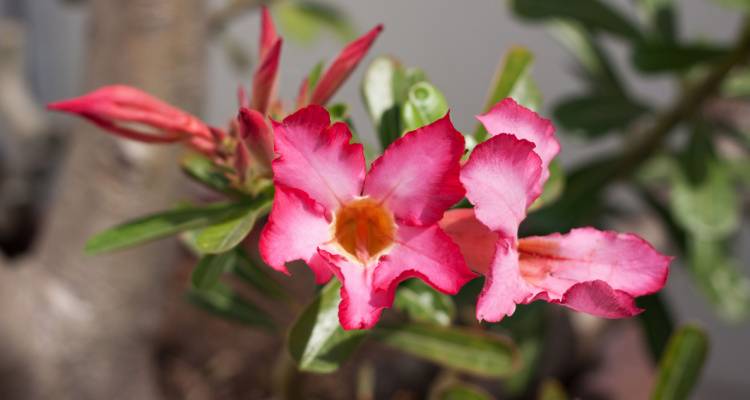
| Light Requirements | Bright direct sunlight or filtered shade. Requirements may vary depending on the species. |
| Soil Requirements | Well-drained and moist soil with a pH of 5 to 6. |
| Watering Frequency | Water once per week on average. Soil should remain damp but avoid it becoming soggy and do not allow the soil to dry out completely either. |
| Temperature Requirements | 20°C to 23°C during the day and no less than 15.5°C at night. |
| Space Requirements | Find a suitable spot on the floor if it grows too tall. |
| Average Height | 0.6 to 3.6 metres. |
| Maximum Height | Up to 6 metres or more. |
| How Often Does It Need Re-potting? | On average, once every 2 to 3 years. |
| Do These Plants Flower? | It varies depending on the species, but most Gardenias begin to bloom sometime in the summer or autumn. |
| When Do They Go Dormant? | These plants do not have a natural dormancy season. |
Fiddle-Leaf Fig Tree
Fiddle-Leaf Fig Tree is a part of a mulberry and fig family known as Musaceae and is native to western Africa. This is a good choice for experts as it has particular needs, you need to be attentive to in order to sustain its healthy and lasting growth.
| Light Requirements | Plenty of indirect light but also some direct sunlight. |
| Soil Requirements | Well-draining soil that is rich in humus with a pH level of about 6-7. |
| Watering Frequency | About every 7-10 days (or when the top inch or two of the soil has dried, and the leaves are becoming a bit floppy). |
| Temperature Requirements | Avoid temperatures of over 32°C during daylight and avoid 10°C or less at night. |
| Space Requirements | Usually, no specific requirements. If it grows too tall, then find a good location on the floor for your plant to keep growing. |
| Average Height | 0.9 to 1.5 metres. |
| Maximum Height | 3 metres. |
| How Often Does It Need Re-potting? | Roughly once every 1-2 years. |
| Do These Plants Flower? | Very rarely. |
| When Do They Go Dormant? | During the winter months. |
Cheese Plant
The Swiss Cheese Plant, despite its name, is actually native to the tropical forests in the south of Mexico. It has special requirements, including temperature needs making it a good choice for an expert plant owner.
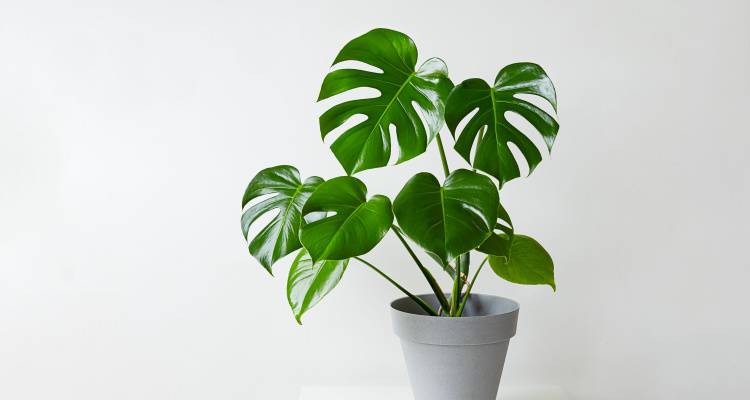
| Light Requirements | Bright shade should suffice. |
| Soil Requirements | Regular potting soil that is rich and nutrient-dense. |
| Watering Frequency | Water once the topsoil becomes dry. |
| Temperature Requirements | 18°C or warmer. |
| Space Requirements | Probably most suited for being positioned on the floor or elsewhere with sufficient headroom. |
| Average Height | 1-2 metres. |
| Maximum Height | About 3 metres. |
| How Often Does It Need Re-potting? | On average, every year or two. Do so during the winter months. |
| Do These Plants Flower? | May bloom after several years. |
| When Do They Go Dormant? | Usually, during the winter months. |
Crocodile Fern
Crocodile Ferns have a texture to them that resembles the skin of a crocodile. These plants are good options for experts as they require a lot of regular attention.
| Light Requirements | Bright but indirect light. |
| Soil Requirements | Well-draining potting soil. |
| Watering Frequency | Water once the top of the soil begins to feel dry. |
| Temperature Requirements | A minimum of 5°C and a maximum of 35°C. |
| Space Requirements | No specific requirements. |
| Average Height | 0.6 to 1.5 metres. |
| Maximum Height | 1.5 metres or above. |
| How Often Does It Need Re-potting? | Re-pot once the roots appear out of the bottom of the drainage holes. |
| Do These Plants Flower? | No. |
| When Do They Go Dormant? | Usually during the winter season. |
Croton
Crotons are native to the southern hemisphere and are a challenging plant to manage, making it a good candidate for expert plant owners to consider.
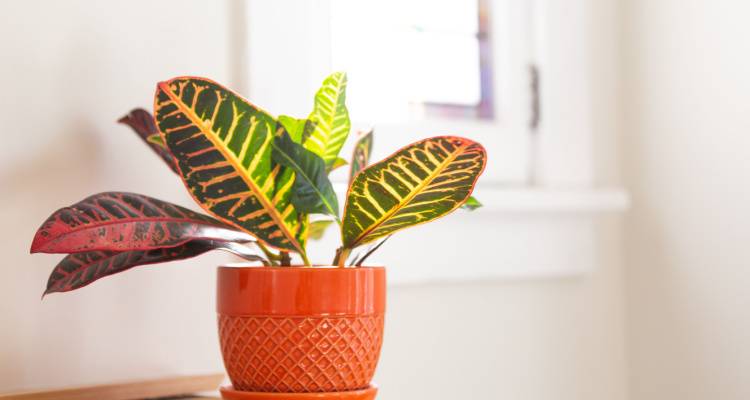
| Light Requirements | Several hours of direct sunlight or/and bright, indirect sunlight. |
| Soil Requirements | Rich soil (peat moss and organic material will work well). |
| Watering Frequency | Daily or weekly depending on the plant and season (or once the soil has gone dry). |
| Temperature Requirements | 21°C to 27°C during the daytime and about 18 °C at night. |
| Space Requirements | Usually, no specific requirements. If it grows too tall, then find a good location on the floor for your plant to continue growing. |
| Average Height | 1 – 2.5 metres. |
| Maximum Height | About 3.6 metres. |
| How Often Does It Need Re-potting? | Roughly annually for the first 3-5 years of the plant's life and less so after (only when the roots are growing out of the container). |
| Do These Plants Flower? | Yes, usually during the warmer months. |
| When Do They Go Dormant? | During the winter months. |
House Plant Essentials
There are certain tools that you will need for the management and upkeep of your house plant. Each of the things discussed below can play an intricate role in plant maintenance and ultimately in the survival of your plant long-term.
House Plant Potting Soil
Soil is, of course, essential for the growth of your plant. Potting soil is the medium to grow your plant in. Potting soil usually comprises perlite, peat moss and bark. Additional ingredients such as vermiculite (a rock derivative) may feature, and not all of the aforementioned ingredients will necessarily be included.
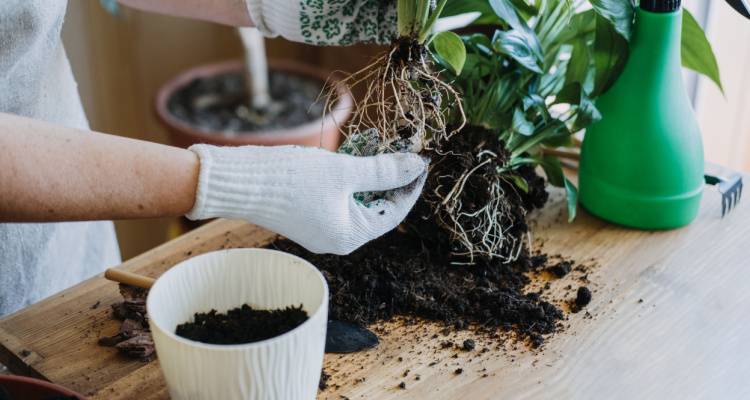
Potting soil describes any growth medium that uses soil/dirt as a plant growth medium while potting mix, an alternative choice is any soilless medium for growing plants in. You may use either although potting soil is arguably the more popular of the two.
House Plant Pot & Saucers
A plant pot or saucer contains the soil in which your plant grows. The use of a pot or saucer is important to keep the soil together and to allow your plant to grow in a stable manner.
Further, these containers also help to support airflow circulation around the roots of your plant. Ceramics and plastic are two of the most popular materials used for such containers.
House Plant Secateurs
House plant secateurs or pruners are used to remove branches or stems from a plant that is diseased, disfigured, dead or damaged. There are two types of house plant secateurs; anvil and bypass. Anvil blades are similar to the blade of a knife as they cut directly through the plant onto a cutting board.
Bypass blades, on the other hand, cut at a slight angle. When cutting, the hook should be positioned at the bottom with the blade at the top. You also want to cut at not too steep of an angle as this could cause the bud to dry.
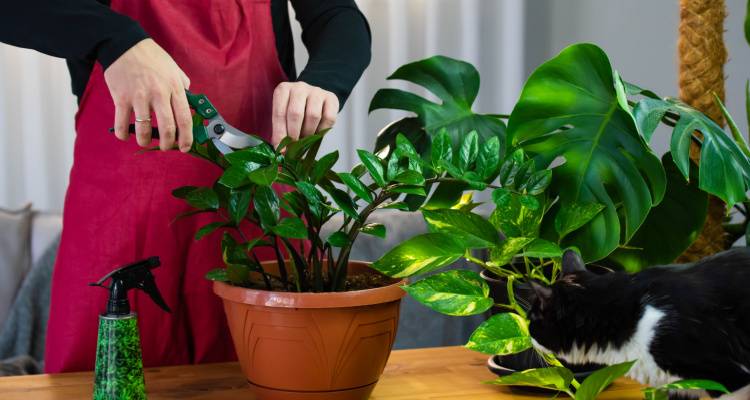
Ensure that you take the necessary precautions when utilising a house plant blade of any kind. For example, you might decide to purchase cut-resistant gloves, although simply holding the blade in the correct manner and keeping your fingers out of harm’s way on either side of the cut should suffice.
You should also avoid trying to cut branches which are more than ¾'s of an inch in diameter as this could damage your pruners.
House Plant Fertiliser/Food
The purpose of plant fertiliser is to provide plants with their essential nutrients for growth. This includes nutrients such as Phosphorus, Nitrogen and Potassium, which are known in the plant world as the ‘Big 3'.
Each given house plant has varied needs and therefore, how often and in what quantities you should use plant fertiliser will depend on which plant you have.
Watering Tool
You'll also need something to water your plants with, whether it's a bucket, sprinkler or even a cup. As with plant fertiliser, how much water you give to your plant and how often will depend on the plant itself.
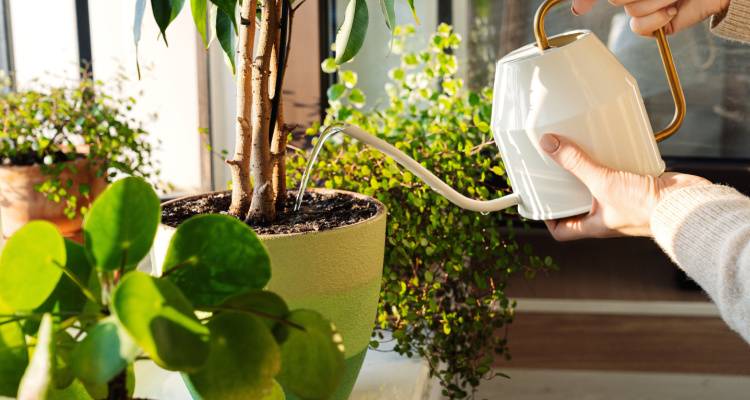
Choosing the Right Plant for Your Home
Finding the ideal plant for your home is important for a list of reasons, ranging from aesthetics to health and safety to choosing a plant that will fit well in your home, given the available room.
Light
Some plants require direct sunlight, so in that case, you'll need to consider how accessible your windows are to sunshine. South or east-facing homes are ideal in this case. On the other hand, if you have minimal access to direct sunlight, there are many plants which can survive with artificial light alone, such as the Snake Plant and Boston Fern Plant.
Time
How much time do you have to take care of a plant? If you've got a hectic lifestyle and worry that you'll forget to water your plant here and there, it is best, in this case, to choose a plant from our beginner's list such as Succulents or Cacti. If you have the time to pay close attention to the needs of your plant, then perhaps a plant from our lists for intermediates or experts might be more up your alley.
Pets and Children
When it comes to pets and children, the primary concern you need to consider is whether or not the plant is poisonous. Lilies, Ivy, Jade, Dumb Cane and Elephant Ear Plants, to name a few are examples of plants that could be harmful and even lethal to pets or/and children.
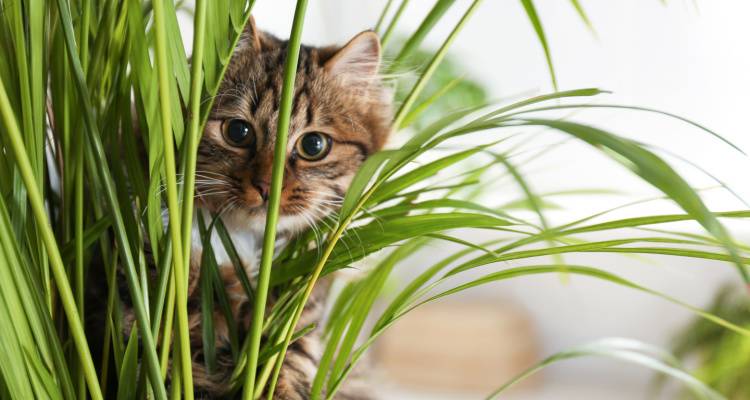
Make sure to check whether or not a plant is poisonous to pets or humans prior to purchasing. Another concern, of course, is whether they may be destroyed.
That is best judged on a personal level with your knowledge of whether your pets or children are likely to damage a new plant and then you should consider where might be safer to place it if you do decide to make a new purchase.
Air/Ventilation
Good ventilation is not only important for your own health, but it can be beneficial to the health of your plant. The better the air quality, the better your plant will flourish. This is especially true for plants that are more dependent on the air, such as, of course, the Air Plant.
Humidity
Certain plants are more tolerable to varying humidity levels than others. If you live in a region where humidity levels are unsuitable for certain plants or vary greatly, then you might need to narrow your options so that your plant does not die due to any given humidity levels.
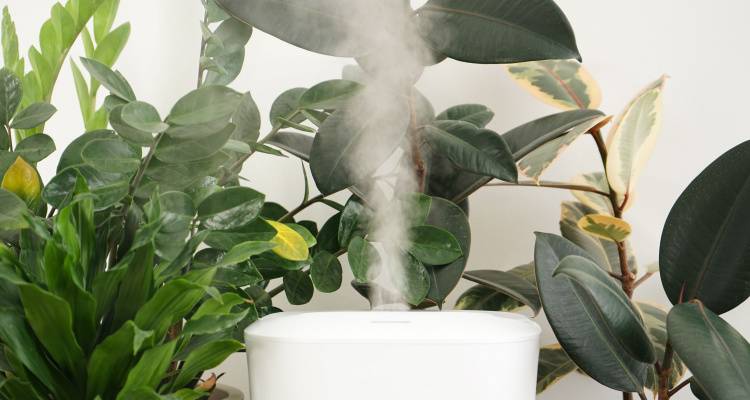
House Plant Care
Taking care of your plant is necessary for it to survive and thrive. In the table below, we look at what is required to take care of a plant.
| What Is Expected? | Water, light, warmth, the correct temperatures and the right soil are all fundamentally important. |
| What House Plant Care Is Essential? | Watering your plant and every so often, feeding it with fertiliser is essential. Furthermore, many plants will require re-potting once in a while. |
| How Often Should Tasks Be Undertaken? | It varies greatly depending on the plant. In most cases, you'll want to wait for the topsoil to go dry before watering for example and as for re-potting this should be done when the roots are appearing out of the bottom of the drainage holes. |
| Does It Depend on The Plant? | Yes. |
| How Much Time is Needed for House Plant Care? | Usually, a few minutes at a time should suffice, but it depends on the plant. |
| Does It Depend on The Number of Plants? | Yes. The more plants you have, the more time you'll need to spend as you'll be repeating similar tasks for each of them. |
Where Should I Put My House Plant?
Finding the right location for your plant is important to maximise its chances of growing successfully and living a long life. The location of your plant can also play a role in how likely it is to bloom.
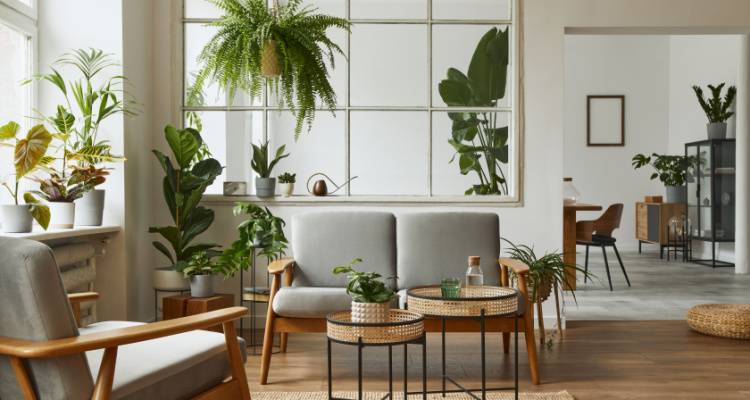
You want to consider factors such as spacing requirements and lighting requirements first and foremost. If your plant requires a lot of sun, then you need to put it by a window with plenty of access to sunlight during the day. If your plant is expected to grow tall, then a suitable spot on the floor will likely be ideal.
Overall, though, it really depends on the plant. Research is the best way to find out how much light a given type of house plant needs, but if you understand your plant well, then you'll begin to grasp its individual needs more specifically as time goes on.
How to Repot House Plants?
Repotting a house plant is the process of taking the plant from a pot of soil and placing it in new soil and a new pot. Once the roots begin to appear out of the drainage holes, it’s time to repot your plant.
You should pick a pot that's about 1-2 inches larger than the previous pot for a slow-growing plant or 2-4 inches larger if it's a faster-growing plant. You'll need gloves, scissors, knife and trowel in order to undertake this task. Usually repotting should be done when the plant is not flowering (generally between during the autumn and winter) although it depends on the plant.
Some plants are more difficult to repot than others. How often plants will need to be repotted varies significantly. In some rare cases they may need repotting more than once a year but generally repotting will be needed every year or even just every few years.
How to Get Rid of House Plant Insects?
In this section, we will look at how insects can harm house plants and how to stop them. Whiteflies and Red Spider Mites are just some of the insects that could harm your plant.
Aphid
Aphids are small green insects which may harm plants by injecting toxins into them or by transmitting viruses from one plant to another.
Symptoms of Aphid damage include stunted or yellowing leaves, the existence of a sticky substance on the stems or leaves of the plant, the distortion of flowers or leaves and the formation of galls on the leaves or roots of the plant.
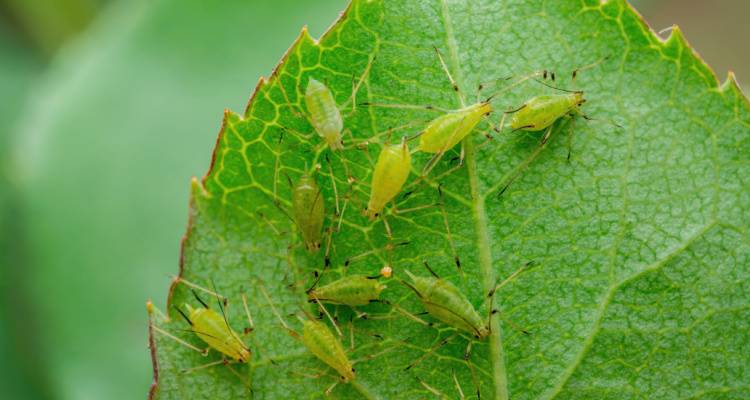
Applying Isopropyl alcohol or ethanol to your plant is a good way to treat this problem. You should apply this substance on a small part of your plant as a test run initially to check it doesn't cause further harm before applying it to the plant as a whole.
Running test runs is a good rule of thumb for treating a plant for any infestation. Also, these substances can be harmful to pets or, so make sure you take any necessary safety precautions.
Mealybug
Mealybugs can remove the sap from the leaves and stems of a plant. Symptoms of Mealybugs include the yellowing of leaves as well as the deforming of leaf growth. The use of soapy water or once more isopropyl alcohol or ethanol can help deter bugs from harming your plant. Once again take the necessary precautions for your plant and for if you have any pets or children.
Whiteflies
Whiteflies can directly damage your plants by sucking out juices from it. Symptoms are similar as with the aforementioned insects with deformed leaves and the yellowing of leaves being common symptoms.
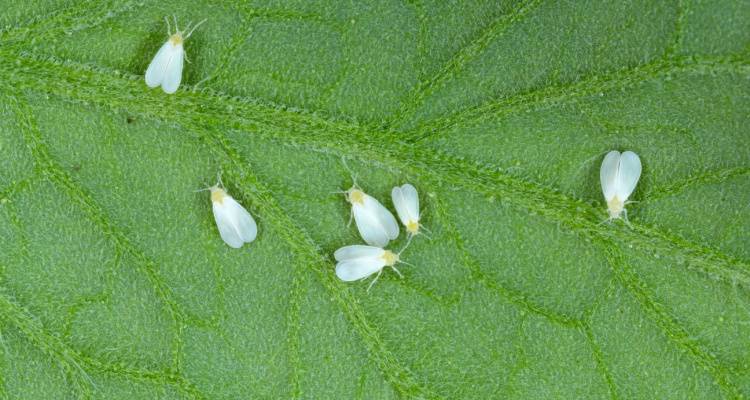
Other symptoms include the appearance of black and sooty mould on the honeydew (a sticky substance) that the insects may leave behind. You can use the same approach to treat Whiteflies damage as with Archids and Mealybugs.
Scale Insect
Scale insects could also harm your plant by sucking the juices out of it. Symptoms once more include deformed leaves as well as the yellowing of leaves.
However, scale insects might also leave brown marks behind. A similar treatment as already mentioned could work, but you might also consider using an insecticidal soap.
Thrips
Thrips also seek to suck the sap out of plants. Beyond that, they may scrape the flowers or/and the leaves of a plant. Among symptoms of Thrip damage is that the leaves could discolour and appear splotchy.
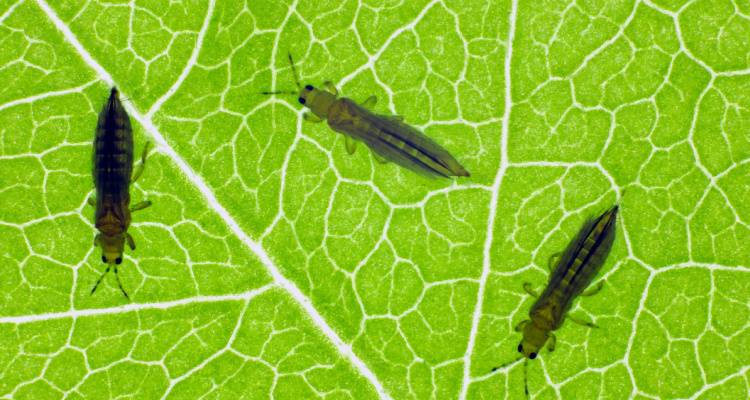
The plants may also become somewhat twisted. Insecticidal soap applied to your plant should stop the appearance of Thrips. This should be done as a several days process.
Red Spider Mites
Red Spider Mites are mites which feed on the juices of plants. Premature leaf loss and spotty or discoloured leaves are signs of Red Spider Mite damage.
A short-living pesticide that is low in toxicity should be initially applied if there is a large population of such insects on your plant. Insecticidal soap can also be applied in the days following to ensure no re-infestation.
Fungus Gnats
Unlike the insects mentioned previously in this section, Fungus Gnats are not actually harmful to your plants. With that said, their larvae may feed on the roots of plants which can lead to harm.
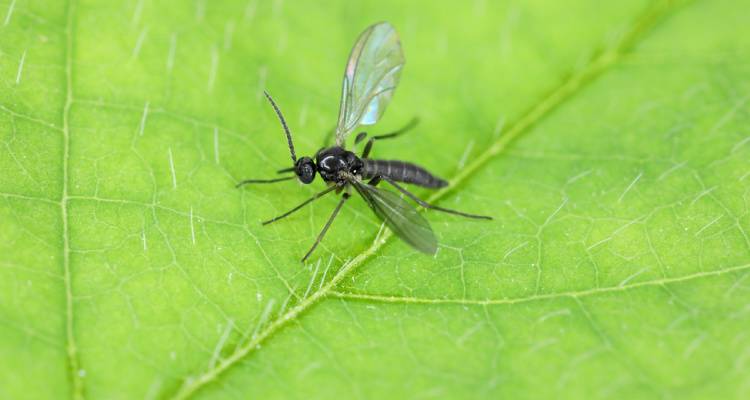
If you see a fog of tiny insects fly away upon walking up to your plant, then there is likely a Fungus Gnat infestation. Soapy water should do the job if applied to your plant through a spray.
How to Spot Disease in House Plants?
Now we will look at some potential diseases that your plant could be stricken with and how you can spot such diseases.
Grey Mould
Grey mould comes in the form of mushy, grey, soft spots. The spots may have fungus spores attached to them. You should use secateurs to prune your plant as this will improve airflow. Using a small fan may also support air circulation.
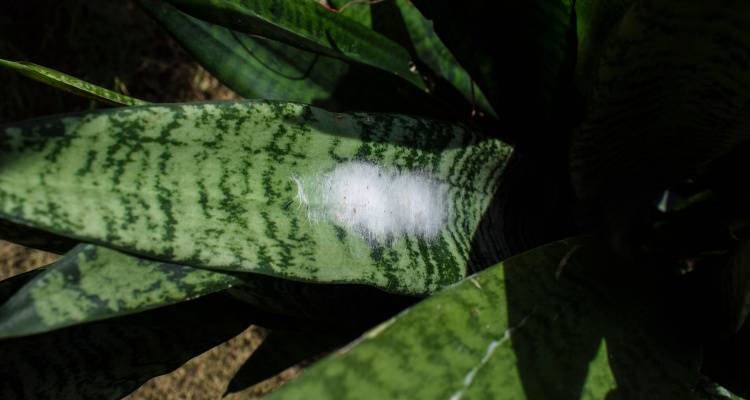
Keep the soil clean and remove any fallen plant parts present in the soil. Copper-soap fungicides can help as more of a preventative measure. Grey mould if left untreated, can kill your plant.
Powdery Mildew
Powdery Mildew will cause a white to grey powdery appearance on the leaves of your plant, and it can also cause the leaves of your plant to curl. Home remedies may help to fight powdery mildew.
This includes the option of a mixture of baking soda (a tablespoon), ½ a teaspoon of non-detergent soap in liquid form as well as a gallon of water. Spray this on to your plant to help treat the disease.
This disease might stifle flowering and slow plant growth while in some rare cases, and if left unattended, it can be fatal for a plant.
Leaf Spot
Evidence of leaf spots is easy to see with brown, tan or black spots appearing on the leaves of your plant in varying sizes. One way to treat this disease is with a copper-based fungicide on a weekly basis. Leaf spots can cause parts of the plant to die and fall off.
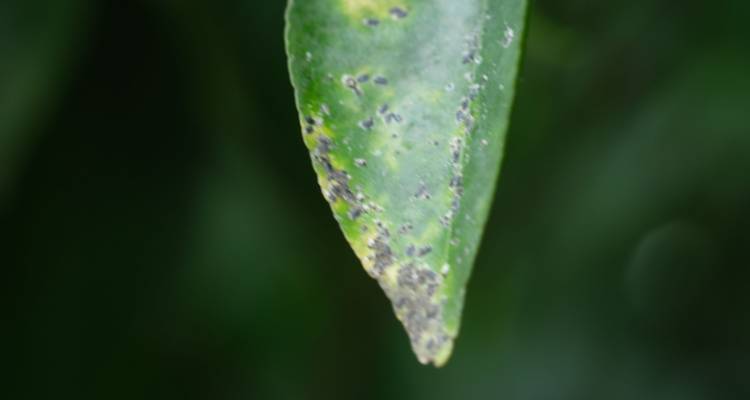
It will also weaken the plant's abilities to fight off other problems such as additional diseases or insects, although leaf spots are usually not directly fatal, especially if properly treated.
Root Rot
One of the biggest concerns for plant owners is root rot. Roots may change colour, become soft and in some cases fall off the plant itself if a plant catches this disease. If root rot happens, you should remove the plant from the soil and wash its roots thoroughly. You should repot the plant in fresh soil to give it a new lease of life.
Root rot can damage a plant in any way imaginable from deforming its branches to weakening its structure as a whole to stunting growth. Ultimately, if left untreated, root rot can kill a plant.
Tips to Prevent Pests and Disease
For this section, we will briefly look at ways that you can prevent pests and disease from harming your plants in the first place.
Tips
- Use Healthy Soil – Make sure you buy fresh and appropriate soil for your plant to begin with. This gives a plant a strong immune system and in turn, makes all potential threats posed by insects and disease alike less dangerous.
- Prevent Insects – Applying herbs near your plant can deter insects.
- Rotate Your Plant – By rotating your plant, you reduce the risk of insects attacking them as if there was a minor infestation beyond your knowledge, it would focus that infestation on less of a centralised area. In turn, this makes a large infestation less likely.
- Use Fertiliser – Using fertiliser once in a while can help boost your plant's health and in turn improve its chances of fighting off disease or pests.
- Water in The Morning Time – Since an environment that is both damp and cool is ideal for a range of fungal-based diseases, watering in the morning instead of later in the day improves the odds of your plant not catching a disease to begin with.
FAQs
Q: How Long Do Orchids Last For?
A: Orchids generally live for 15-20 years although they may live for decades more.
Q: Why Won't My Peace Lily Blossom?
A: Usually, this is because your Peace Lily does not have access to enough light.
Q: Why Does My Spider Plant Have Brown Tips?
A: The most common explanation is water-related stress. This can be caused by either under or over-watering. You can tell if it's an issue of over-watering if you are failing to wait until about an inch of the topsoil has dried before watering. If you are waiting until this point, then it may be a problem of under-watering.
Q: What Does A Snake Plant Look Like?
A: This plant has leaves that point up with a resemblance of swords. It is also green toned in colour with lighter green colours around its edges.
Q: Why Have the Leaves of My Peace Lily Become Yellow?
A: This tends to be the result of either too much or too little light.
Sources:
https://www.exploratorium.edu/gardening/feed/dirt/pottingsoil.html
https://www.gardeningknowhow.com/garden-how-to/tools/using-garden-shears.htm
https://mrec.ifas.ufl.edu/foliage/folnotes/spider.htm
https://www.almanac.com/plant/spider-plants
https://www.britannica.com/plant/cactus
https://gilmour.com/growing-succulents-indoors
https://www.proflowers.com/blog/lucky-bamboo-care
https://www.houseplantsexpert.com/cast-iron-plant.html
https://www.ourhouseplants.com/plants/jade-plant
https://pistilsnursery.com/blogs/journal/air-plant-care
https://www.waterpebble.com/watering-african-violet/
http://www.avsa.org/learn-violets101
https://www.bhg.com/gardening/plant-dictionary/houseplant/african-violet/
https://www.nature-and-garden.com/gardening/dieffenbachia-care-watering.html
https://www.thesill.com/blogs/plants-101/how-to-care-for-moon-valley-pilea-pilea-mollis
http://www.beautifulorchids.com/orchids/orchid_care_tips/watering/watering.html
https://www.epicgardening.com/zebra-plant/
https://www.nature-and-garden.com/gardening/banana-tree.html
https://bantam.earth/crocodile-fern-microsorum-musifolium-crocodyllus/
https://getbusygardening.com/how-to-kill-mealybugs/
https://www.planetnatural.com/pest-problem-solver/houseplant-pests/thrips-control/
https://www.tenthacrefarm.com/preventing-garden-pests/
https://www.tenthacrefarm.com/preventing-garden-pests/
https://foliagefriend.com/houseplant-statistics/
Last updated by MyJobQuote on 31st July 2024.







